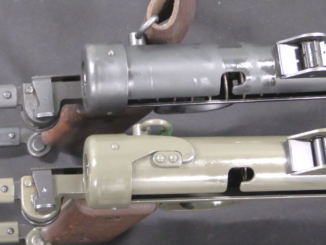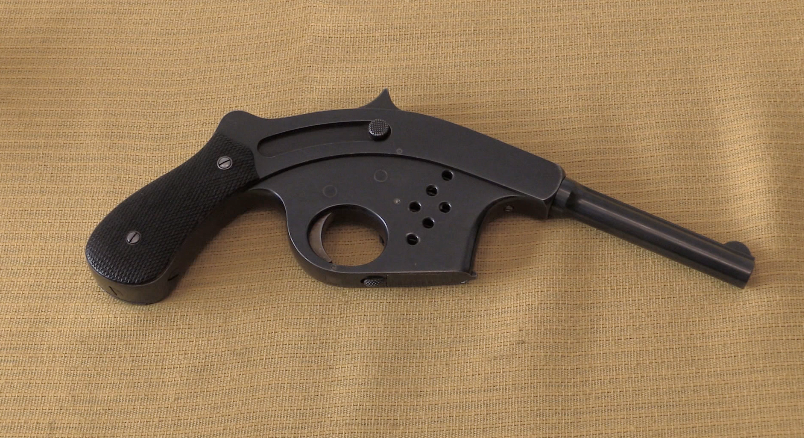Being right in the depths of winter, it seemed like a good time to take a Scandinavian rifle out to the range. Specifically, a Swedish Ljungman AG-42B. This is one of the few semiauto military rifles chambered for a full-power cartridge lighter than the 7.62 NATO (the other common one being the FN49 in 7×57), and I was curious about whether that lighter round would really make much difference in how the rifle felt. The answer? It definitely does.
The Ljungman is a bit of a bulky rifle, with a fairly long action and stock. Shooting it is very pleasant, though. The light-ish cartridge and muzzle brake make for fairly mild recoil, and a very controllable gun. It sure does fling brass, though – close to 20 feet ahead and slightly to the right.
If you would like to see more on the inner workings of the AG-52B, you should take a look at our previous video on the Ljungman, which has us disassembling one in the shop.




Great vid!
I had one years back, and a Hakim too. The Ljungman was extremely fast and accurate and took the standard Swedish bayonet. A joy to shoot but on the heavy side. never had a malfunction with it. The Ljungman was extremely well build, far better than the poorly built Hakim in 8mm Mauser.
This is a great rifle to shoot.
I am curious about the timing. What replaced the AG42B? Other than the swedish mauser, is there anything else that shoots the 6.5 swede round/
The H&K G3 (license-built as the AK-4) replaced the Ljungman. As far as the 6.5×55 goes, there is a huge number of civilian arms that chamber it – if it uses a standard-length (63mm to fit the .30-06) action, it’s probably available. Military wise the Norwegians and Swedes obviously chambered their machine guns in the cartridge, but also the Norwegians used the Krag-Jorgensen rather than the small ring Mauser.
The Norwegian Krags also used 6.5x55mm. And Sweden had their version of the BAR chambered in it, while Norway used it in Madsen machine guns.
Then they both took a step backwards by switching to 7.62 NATO. In Sweden’s case, I really don’t understand why, since not only were they not a NATO member, their neutrality meant they weren’t even getting military aid from the US.
Sweden actually had a few “secret” collaborations with US/NATO. Like for example prepared locations in swedish waters for US missile submarines, before they had missiles with longer range
Also IIRC NATO did not want Soviet to get hold of the scandinavian peninsula, since its a good location for airbases.
And neutral or not you would want to use the same type of standard ammunition as the side you will end up on anyway if a new world war happened.
Btw in simulations in swedish military training the enemy was always Soviet and after the fall of that the enemy always had russian equipment.. odd eh 🙂
I purchased an AG42B from SARCO back in the 1990s. You could buy a sealed combat back of ammo fairly cheaply as well.The rifle is sweet to shoot and easy to maintain It is similar to an M1 Garand as to accuracy, but with less recoil. Do not expect accurate fire with the bayonet fixed.
When we talk about the “size” of a bullet, we need to keep in mind that there are more dimensions than just the diameter. There is also the length and the profile or shape.
The 6.5mm Swedish “spitzer” bullet weighs 9 grams. That is only about 5% lighter than the 9.5 g of a standard 7.62 NATO bullet. The original round nosed 6.5mm Swedish bullet weighed 10.11 g – which is about 6% *heavier* than a modern 7.62 NATO. The other common 6.5mm bullets such as the Arisaka and the Carcano were similar (the Carcano never came in a spitzer version, but the round nosed one weighed 10.5 g). Because of the long cartridge case, the complete 6.5mm Swedish round weighs virtually the same as a 7.62mm NATO round.
These rounds were less powerful than 7.62mm NATO, but that primarily came from firing the bullets at a lower velocity. The spitzer version of 6.5mm Swedish had a muzzle velocity of 800 m/s, as compared to 850 m/s for 7.62 NATO. The result was a muzzle energy of 2890j for 6.5mm Swedish, as compared to 3380j for 7.62mm NATO (or about 15% less). The formula for kinetic energy is 1/2mv^2 (one half the mass times the square of the velocity), so muzzle velocity is what mainly accounts for the difference.
Since a smaller diameter bullet has less base area to push on, it’s quite possible (I don’t actually know though) that the designers settled on a lower velocity (and energy) in order to keep the chamber pressure within reason for the metallurgy of the day.
The only real major outlying bullet on the small end seems to be 7.35×51 Carcano, where the bullet weighed 8.4g. This was the lightest military rifle bullet adopted (on a major scale) until the 7.92x33mm Kurz (8.1g), or 7.62x39mm M43 (8g), which were the first real assault rifle rounds. However, it was also one of the newest rounds developed before the aftermath of WWII wiped the slate clean again.
Where I’m going with this is that most countries seemed to have settled on one of two choices in terms of bullet diameter by the start of the 20th century. One group settled on 7.5 to 8mm, and the other on 6.5mm. A few did pick 7mm, but not that many and none of them were major countries. The exact choices were round numbers (6.5mm, 7.5mm, 8mm, 0.303 inches, 0.3 inches, 3 Russian “lines”), so the exact sizes were to some extent arbitrary round numbers rather than based on some exact scientific principle.
It would be interesting to know the factors that went into the decision making processes for each of these choices. It can’t have been availability of ammunition, because none of these rounds were compatible with each other, even if they were the same calibre. It can’t have been based on “we want a smaller/bigger bullet”, because as we have seen, most of the bullets were pretty close to the same weight, just different proportions. Bullets did get lighter as part of the move from round nosed to spitzer, but the point I’m trying to make is that the 6.5mm ones weren’t “small” when compared by weight to supposedly “larger” ones.
I haven’t seen any explanation of how this process occurred, and perhaps at this stage nobody really knows. Or maybe nobody really cares enough to dig through the archives. For myself though, I find the history of the ammunition to be as fascinating as the history of the firearms which used it. Modern firearms were not possible without the ability mass produce the ammunition for them, and are little more than curiosities once that ammunition is no longer available.
On another note, the USA is currently working on caseless ammunition based on technology developed (and abandoned) by the Germans in the last century. Personally, I have doubts about the practicality of the concept, but perhaps it will all work out. If it does really work and it does become adopted by NATO countries (there’s no guarantees there either), then is is also possible that this new ammunition will never be available on the civilian market. That won’t affect hunters and normal target shooters. It will affect (primarily American) hobbyists though who like to buy “military looking” firearms. Their existing rifles won’t suddenly evaporate, but the military and civilian markets will completely bifurcate, and eventually today’s “military style” civilian firearms will be as obscure as the Ljungman AG42B.
The smaller calibers with fairly heavy bullets (6.5mms, ~9gs) were an attempt to increase the sectional density and thus maximum range at which you could penetrate a target (usually not any kind of helmet or armor, as those did not become popular until the first world war, more likely wood palisades, or horses), as well as increasing your ballistic coefficient so that the maximum range of your rounds (which means something very different today than it did then) was greater than the maximum range of the rounds of the next guy.
The logical conclusion to this was the 6mm Lee Navy, which, by all accounts, was a ballistic marvel that could have really shaken things up… If the high-nitroglycerine, high-temperature powders of the time hadn’t been barrel-eaters. In the 1970s, Frankford Arsenal (in something of a last gasp before the arsenal closed) complete work on the 6mm SAW, whose 105gr bullet fired at 2,520 ft/s produced very similar performance to the late 6mm Lee Navy loading of 112grs at 2,560 ft/s, though the SAW’s bullet was a well-streamlined spitzer. However, by this time, the SCHV concept had been well-proven, and an improved loading of 5.56 NATO (which would become M855) was chosen instead.
Hi, Nathaniel :
In the FW article about the Colt CMG-2 LMG in September, 2012, I had discussed the Frankford Arsenal 6mm x 45 SAW round with Keith, so it’s really great to see you add another dimension to the pool of historical knowledge about this particular cartridge, which held so much promise but was unfortunately sidelined by the prevailing circumstances of the time. Thanks!
Was the AG42 inspiration for the M16? Both use direct gas correct?
Mike, they actually don’t work the same way and aren’t related. The AG-42 uses a jet of gas to push the bolt carrier rearwards directly, whereas the AR-15 taps gas into the bolt/bolt carrier assembly itself into a little expansion chamber which pushes the bolt and bolt carrier in opposite directions, unlocking the gun and then cycling the action.
I love my AG42Bs. They are great rifles and the action is unique.
nice informative vedio thanks for sharing
Aaaaand now I want one.
Great to see a AG42 again,back in the days when we in the
UK could own semi auto rifles i had an AG42 an L1A1 and
a Valmet M76 the AG42 was the most fun to use we used to
remove the ruber buffer and fit a case catcher to it to save the cases and too prevent you neighbour on the range from getting a case stuck in the side of his head,
very very accurate rifle i shot the best group i have ever shot with open sights with mine 10rds all in a 3inch
spotting disc at 300 yrd. I still love the 6.5x55rd have
an 1943 Husqvarna 38M great gun.